| MESCELLANY |
YEAR: 1957
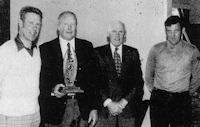 |
| Les Purvis, Len Butterworth, George Kelly & Neill Escott |
The recent death of Len Butterfield, a highly-respected former Chief Stipendiary Steward, revived memories of the infamous whip slashing incident at Addington in 1957. Butterfield, who was appointed Chief Stipendiary Steward for the NZ Trotting Conference that year, suspended driver Cecil Devine and Jack Litten for six months over the affair.
Butterfield chaired the three-person panel - it also included another stipendiary steward and a club steward - which laid the charge, conducted the inquiry and imposed the penalty. Harness racing adopted the thoroughbred racing system of judicial control in 1997, with stipendiary stewards acting as prosecutor only and a Judicial Control Authority person and panel assessing the evidence and imposing penalties. One member of the JCA in now the norm for all except the major racemeetings, when two are appointed.
Devine and Litten struck at each other with their whips about 250m from the finish of the NZ Flying Stakes on the fourth day of the Cup Meeting. Devine was driving Don Hall with Litten (False Step) on his inner. The pair were fighting out second and third placings in a gap behind Caduceus, then a stablemate of False Step in the Litten stable. Caduceus, driven by Tony Vassallo, won the mobile start race by five lengths, posting his 29th win. False Step finished second with a length to Don Hall in third.
A Press Association report in the "Times" read:
"It is understood Devine and Litten slashed at each other outside the furlong post. Inside the furlong, Litten turned and hit at both Don Hall and Devine. As the horses were pulling up, half a furlong past the finishing point, Litten slumped in the sulky holding the left side of his face. He was still obviously in pain, with his left eye closed on returning to the birdcage, where he and Devine were greeted with boos and cat-calls from many hundreds of people both on the inside and outside enclosures. The payment of place dividends on False Step and Don Hall was delayed until proceedings concluded three hours after the race. The inquiry was adjourned to call additional witnesses."
False Step, who won the 1955 NZ Derby for Litten, and six races as a 4-year-old, did not win at five and was transferred to Devine in 1958. He won the NZ Cup that year, and again in the following two years. Butterfield and Devine had numerous clashes which developed into a feud.
Butterfield ordered the removal of a neck pricker from False Step on the second day of the Inter-Dominions at Addington in 1961. The gear, blunted tacks attached to the inside of the neck band to prevent a horse veering out at the start of a race was illegal. False Step had set a world record for 13 furlongs when he finished second to Diamond Hanover fron 48yds on the first day wearing the pricker. He ran outsider Massacre to a nose in the Final. Massacre who had won four races, scraped into the Final after placings in two heats.
Butterfield, who began work with the Trotting Conference in 1946, was Chief Stipendiary Steward for 21 years until he retired at 65 in 1978.
Hopple shorteners are now accepted gear for pacers but Butterfield disallowed their use briefly in 1968 at the Inter-Dominions, causing controversy. Trainer-driver Dick Benger was barred from using shorteners on the Australian pacer Lord Setay. The horse fell in the opening round of heats and the gear was permitted for the remainder of the series after representations from the Australasian Council of Kindred Associations to the Inter-Dominion Conference.
Credit: Taylor Strong writing in HRWeekly 1Sep99
YEAR: 1956
The present Challenge Cup for the winner of the New Zealand Cup was presented for the first time in 1956. The gold cup was insured at the time for £850 and was retained by the winning owner for a year. In 1956 a silver salver was also presented with the cup, this was retained permanently by the winning owner.
In announcing the change the retiring President of the NZ Metropolitan Trotting Cup, Mr C E Hoy, reported that over the last few years the club had experienced great difficulty securing suitable gold cups. Costs had risen steeply, and cups in keeping with the occasion were almost impossible to secure. If imported, they were subject to heavy import duty. Numerous specifications were obtained both in New Zealand and overseas for the challenge cup, and a cup of outstanding design had been ordered from an English firm.
Credit: NZ Trotting Calendar
YEAR: 1954
TROTTERS ELIGIBLE TO ENTER NZ CUP
For the first time since 1928, when the American stallion Peterwah was in the field, a trotter - or trotters - will have the opportunity, this year, of competing in the NZ Cup.
The race is for pacers on 4.23 and faster, and trotters on 4.30 and faster, and the only trotters who qualify at present are Dictation, Gold Horizon and Vodka. All are great stayers, and two of them, Dictation and Gold Horizon, are brilliant enough out of the barrier to be capable of adding a lot of interest to the race. If either of these great square-gaiters should go the early part of the race as fast as they have done in races among horses of their own gait, there will be little chance of any pacer slowing up the field and indulging in some of the leisurely first miles that have detracted from some of the leading handicap races of the past.
To this extent the presence of these class trotters will be welcomed; and they will also bring variety to the premier event.
In the meantime, no one will expect spectacular results from the Metropolitan Club's innovation - for an innovation it is under our present handicapping system - but old-timers will reflect nostalgically on the great performances in the past of trotters among the pacers and express a hope that this latest step may eventually bring to light a Reta Peter or a Monte Carlo both of whom won trotting Cups against fields of pacers; and, only in a slightly lesser degree, a Whispering Willie, a Hardy Wilkes, a Trampfast, Wrackler, Bellflower, Electrocute, Peterwah, Muricata, Submarine, or Moneyspider, all of whom defeated high-class fields of pacers at different periods. There were others.
The public, in the past, greatly enjoyed the exhilarating spectacle of a real trotter coming home at the head of a field of pacers. We have seen too little of this kind of sport of recent years, and the Metropolitan Club, we think, is deserving of bouquets and not brickbats, for its bold step in once again opening the gate to its top class races to the trotter; because, if the trotters play their part as well as many of us feel confident they will, their presence among the pacers in other races will naturally follow as a matter of course.
Credit: 'Ribbonwood' writing in NZ Trotting Calendar 22Sep54
YEAR: 1950
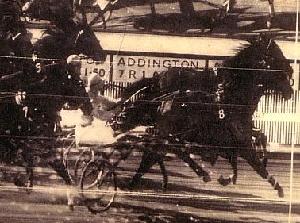 |
| The photo-finish print. |
There was a sensation to the finish of the mile and five furlong Hornby Handicap on Show Day of the 1950 Cup Meeting when Maida Dillon outfinished Fortuna and Gay Piper to win by a nose. The rank outsider of the field, she finished on too resolutely for her win to be declared a fluke.
When the dividends were posted the winner paid £257/12/6 for a win and £37/6/- for a place. Combined with Red Emperor winner of the first leg Hayward Handicap, Maida Dillon returned a Dominion record double dividend of £7948/9/-. She also won her next start, at New Brighton, paying £45, and two others.
A Dillon Hall mare, Maida Dillon was raced on lease by Ron Bainbridge, having won her way out of Southland class, and trained and driven for him by L Frost. Leicester Frost trained for many years at New Brighton and died in May 1989 at the age of 87. This was his most notable accomplishment in harness racing.
Maida Dillon originally came north with a big reputation, but she failed to find form in Canterbury until Frost discovered, by chance, that the best way to train her was galloping along the beach. Said Bainbridge: "It rained throughout May and all Leicester could do was gallop her along the beach. She ran an unlucky third on that preparation, but didn't do a thinh in the spring. Well said Leicester, there's nothing elseto do but to go back and gallop her, like we did in the winter. She didn't respond to hopples at all," recalled Bainbridge.
All told, Maida Dillon won seven races under Frost's care, and finished 12th on the list of stakes winners in the 1950-1 season.
YEAR: 1948
C S HOWELL HANDICAP
This race, which is run at the CPTC's New Year meeting, perpetuates the name of one of the most honourable and respected men in the early days of trotting.
Chas. Selby Howell ran a saddlers shop in Tattersall's building in Cashel Street, Christchurch. Later he handed the business to his sons, who in turn sold it to Messrs Trist and Small. Mr Howell was one of the founders of the Canterbury Park Trotting Club in 1891, and acted as its honorary secretary until 1895, when the late Mr A L Rattray was appointed to the position. In 1897 he was appointed president of the Club, a position he occupied until his death in 1921, with the exception of an interval of three years. He was always in the forefront in anything appertaining to the advancement of trotting.
He was born in Stroud, Gloucestershire and was educated at the parrish school, known as Red Coat School (some dozen boys only wearing scarlet coats and vests, a benefaction left by some ancient hunting squire for that purpose) of which his father was schoolmaster and parrish clerk for over 50 years.
It was he who circularised clubs in the Canterbury district stating that as there were now so many clubs springing up in the district, he felt some controlling organisation was necessary, and he was influential in forming the Canterbury Metropolitan Trotting Association, of which he was president for some years and did yeoman service while acting in that capacity. He was one of a committee which framed the constitution and rules of the Association, the name of which was later changed to the South Island Trotting Association. Later he was instrumental in bringing about the amalgamation with the North Island Trotting Association, and thus was initiated the present NZ Trotting Association.
During the time Mr Howell was president of the Canterbury Metropolitan Trotting Association, they were fighting for Government recognition of the sport and a proper allocation of racing days. In 1896 he sent the following circular to all clubs:
"162 Cashel Street, Ch-Ch.
June 15, 1896.
To Secretary,-
The Canterbury Metropolitan Trotting Association having had under consideration the advisability of all the trotting clubs in NZ moving in the matter of securing their proper allowance of trotting meetings for each province, on the basis proposed for the years 1895 and 1896.
The Racing Conference meets in Wellington during the month of July (date not yet fixed), and endeavour to obtain an interview with the Racing Conference, by a delegate from each of the trotting clubs, and at the same time to act on the advice of the Colonial Secretary to see him a few days before the Racing Conference meets.
That, if possible, each trotting club to be represented by a delegate, and each club to pay their delegate's expenses to Wellington. That a united and energetic effort be made to secure the just and common interest of all trotting clubs in NZ, by obtaining their fair share of the totalisator permits, so that the strongest combination of the clubs is required. The interest and influence of all members of the Legislative Council, and House of Representatives, of each Electorate where trotting meetings are held, would have to be solicited for their assistance in this matter to secure our rights.
Any matters, other than the above, in the interest of trotting could be discussed by the delegates at the same time. Your prompt reply in assisting this will be obvious.
I have the honour to be, Dear Sir,
Yours faithfully, CHAS S HOWELL
President, CMTA"
Thus Mr Howell became the convener and also chairman of the first NZ Trotting Conference and acted in that capacity for several years. A set of rules was drawn up and these form the basis of the present rules. Mr A I Rattray was the first secretary of the NZ Trotting Conference, and though he soon relinquished the position, the effect of his good work remains.
In 1908, in recognition of the wonderful work done for his club and trotting generally, the club commissioned Mr Sydney L Thompson to execute his protrait, and this was later presented to him. On his death the family handed it back to the club, and now it hangs in my office. About 1910 Mr Howell decided to take a trip to England, and prior to his leaving, a dinner was tendered him as a mark of respect and goodwill.
Chas Selby Howell undoubtedly deserved the compliment paid him in the naming of this race.
Credit: H E Goggin writing in NZ Trotting Calendar 28Apr48
YEAR: 1948
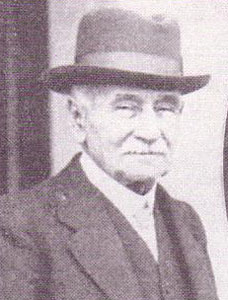 |
This race was run at the NZMTC's Cup meeting until recently and perpetuates the name of the Hon Chas Louisson, who was president of that club from 1906 to 1924. He was one of the pioneers of trotting and took an active interest in the sport from its earliest days. He was a committeeman and steward of the Lancaster Park Trotting Club and was active in securing the ground of the present Addington Course and in making it what it is today.
During his presidency, the enlargement of the course and grounds to its present size was carried out. All the modern buildings on the ground, with the exception of the totalisator houses, were erected during his presidency. He laid the foundation stone of the outside public stand, and his name is engraved on it.
For some years he presented the Cup for the NZ Cup Handicap and was always ready to assist the finances of the club. In recognition of his great services, his widow and son, Dr M G Louisson, the present vice-president, were elected life members of the club.
Credit: H E Goggin writing in NZ Trotting Calendar 12May48
YEAR: 1948
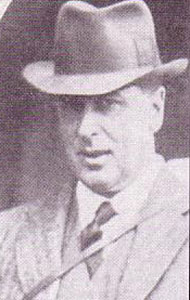 |
This race is run on the second day of the NZMTC Easter meeting and honours the late Mr J H Williams, who did so much for the sport generally.
He was a barrister and solicitor in Christchurch, and joined the NZMTC in 1906. He was appointed a committeeman and steward in 1914, and was made vice-president in 1915. In 1924 he was elected president of the club, a position he occupied until his death in 1939.
In 1916 he was elected to the board of the NZ Trotting Association. In 1925 he became chairman of the board and remained as such for 14 years.
By his enthusiasm, ability and geniality he earned the respect and goodwill of the whole trotting community. The valuable services he rendered to trotting are suitably recognised in the naming of this race, and in the election of his widow as a life member of the NZMTC.
Credit: H E Goggin writing in NZ Trotting Calendar 9Jun48
YEAR: 1948
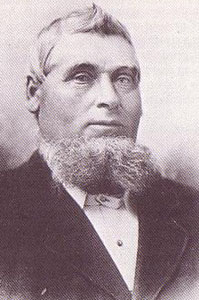 |
| Henry Mace |
This race, until recently, was run by the NBTC, and honours the late Henry Mace, one of thne benefactors of the sport of trotting. He ran a soft-drink business in Christchurch, and was always prominent in public affairs.
The New Brighton racecourse had been purchased from its original owner, Mr Tom Free, by the Canterbury Sports Co Ltd with the idea of encouraging athletics, but this body soon went into liquidation and the course was then purchased by Mr Mace, who established his home, stables and stud there. He called it 'Brooklyn Lodge.' He then set about improving the grounds, sinking deep wells, sowing grass, and erecting buildings, and the present position of the New Brighton Trotting Club, may, to a great extent, be placed to the credit of Mr Mace. Later the course was sold to the Button family, and was subsequently purchased by the New Brighton Trotting Club.
Henry Mace was always a leading light in the government of the sport and anything that would help its advancement. He was on all deputations urging Government recognition of the sport, and with the late Mr A I Rattray and Sir Wesley Percival waited on the Hon R J Seddon with a request that a tax be placed on the totalisator receipts. This, of course, was done to counter the anti-totalisator people, who were particularly strong in those days.
Mr Mace's stud soon developed, until he had about 80 sires, mares and young stock. These were all from the best imported strains and included such well-known names as Almont, Candidate, Mambrino, Abdallah, Brooklyn and Director.
Henry Mace was one of New Brighton Trotting Club's most enthusiastic workers and well deserves to leave his name enshrined in the annals of trotting pioneers and enthusiasts.
Credit: H E Goggin writing in NZ Trotting Calendar 5May48
YEAR: 1948
OLLIVIER HANDICAP
This is the big race on the second day of the NZMTC's Cup meeting, and is in memory of the late Mr C M Ollivier, who was a committeeman and steward of the club for some years, and acted as vice-president under the late Mr J H Williams from 1925 until his death in 1935. During that period he rendered great service in the administration of the affairs of the club, in which he took a very deep interest.
Mr Ollivier owned a number of high-class horses, and in 1922 won the NZ Cup with Agathos. He occupied the stables situated beside the Riccarton Railway Station.
His son, Mr W M Ollivier, has been a committeeman and steward, and also honorary judicial steward of the Metropolitan club for some years. He is also a member of the board of the NZ Trotting Assiciation
Credit: H E Goggin writing in NZ Trotting Calendar 19May48
YEAR: 1948
WILKIN HANDICAP
For many years now the Wilkin Handicap has appeared on the Easter programmes of the NZMTC, but I wonder how many know why the race is so named?
It is to commemorate 'the father of trotting turf' Robert Wilkin.
Robert Wilkin was a merchant in Hereford Street, Christchurch, and had his stables at the corner of Holmwood and Garden Roads, Fendalton. Prior to 1882 there were no clean-bred trotting sires in the Dominion. With the idea of remedying this want, Robert Wilkin commissioned an American trotting authority to send him a collection of three sires and six brood mares. These duly arrived, the sires being Berlin, Blackwood Abdullah and Vancleve, and the brood mares Messenger Maid, Blue Grass Belle, Fannie Belle, Jeannie Tracey, Queen Emma and Woodburn Maid.
These horses did more to improve the type of light-harness horse in the Dominion than any who have arrived since. Vancleve, of course, went to Australia and later was a wonderful success at the stud of Mr J A Buckland, and exercised a great influence on the trotting breed in Australia. Berlin was an immediate success as a sire, his progeny being noted for their stamina and gameness. Two mares by him were also a great influence at the stud, namely Fraulein and Puella.
All the other importations left their mark on the light-harness breed and laid the foundation for the wonderful breed we have today.
Credit: H E Goggin writing in NZ Trotting Calendar 21Apr48
| << PREVIOUS | 1 2 3 4 5 6 | NEXT >> |